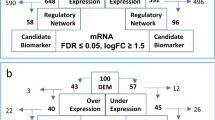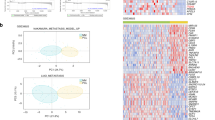Abstract
Multiple myeloma (MM) is a malignancy of terminally differentiated plasma cells and does not have sufficient prognostic indicators. Interferon gamma inducible protein 16 (IFI16) plays a crucial role in B-cell differentiation. Several studies have shown that IFI16 predicted prognosis in many cancers. However, the relationship between MM prognosis and IFI16 expression has not been studied. In our study, we analyzed the prognostic role of IFI16 expression and explored the possible mechanism in MM progression by using 4498 myeloma patients and 52 healthy donors from 13 independent gene expression omnibus (GEO) datasets. The IFI16 expression increased with myeloma progression, ISS stage, 1q21 amplification, and relapse (all P < 0.01). MM patients with higher IFI16 expression had shorter survival in six datasets (all P < 0.05). Furthermore, multivariate analysis indicated that enhanced IFI16 expression was an independent poor prognostic factor for EFS and OS (P = 0.007, 0.009, respectively). And PPI, GO, KEGG, and GSEA also confirmed that IFI16 promoted MM progression by participating in tumor-related pathways. In conclusion, our study confirmed that IFI16 was a poor prognostic biomarker in MM.
This is a preview of subscription content, access via your institution
Access options
Subscribe to this journal
Receive 6 print issues and online access
$259.00 per year
only $43.17 per issue
Buy this article
- Purchase on Springer Link
- Instant access to full article PDF
Prices may be subject to local taxes which are calculated during checkout






Similar content being viewed by others
References
Kumar S, Rajkumar V, Kyle R, van Duin M, Sonneveld P, Mateos M, et al. Multiple myeloma. Nat Rev Dis Primers. 2017;3:17046.
Gonsalves WI, Gertz MA, Gupta V, Rajkumar SV, Morice WG, Timm MM, et al. Prognostic significance of quantifying circulating plasma cells in multiple myeloma. Clin Lymphoma Myeloma Leuk. 2014;14:S147.
Went M, Sud A, Speedy H, Sunter NJ, Försti A, Law PJ, et al. Genetic correlation between multiple myeloma and chronic lymphocytic leukaemia provides evidence for shared aetiology. Blood Cancer J. 2019;9:1.
Rajkumar SV, Dimopoulos MA, Palumbo A, Blade J, Merlini G, Mateos M, et al. International Myeloma Working Group updated criteria for the diagnosis of multiple myeloma. Lancet Oncol. 2014;15:E538–48.
Walker B, Mavrommatis K, Wardell C, Ashby T, Bauer M, Davies F. et al. A high-risk, double-hit, group of newly diagnosed myeloma identified by genomic analysis. Leukemia. 2019;33:159–70.
Landgren O, Kyle R, Pfeiffer R, Katzmann J, Caporaso N, Hayes R. et al. Monoclonal gammopathy of undetermined significance (MGUS) consistently precedes multiple myeloma: a prospective study. Blood. 2009;113:5412–7.
Kyle R, Remstein E, Therneau T, Dispenzieri A, Kurtin P, Hodnefield J, et al. Clinical course and prognosis of smoldering (asymptomatic) multiple myeloma. N. Engl J Med. 2007;356:2582–90.
de Larrea C, Kyle R, Durie B, Ludwig H, Usmani S, Vesole D. et al. Plasma cell leukemia: consensus statement on diagnostic requirements, response criteria and treatment recommendations by the International Myeloma Working Group. Leukemia. 2013;27:780–91.
Tiedemann RE, Gonzalez-Paz N, Kyle RA, Santana-Davila R, Price-Troska T, Van Wier SA. et al. Genetic aberrations and survival in plasma cell leukemia. Leukemia. 2008;22:1044–52.
Ludlow LEA, Johnstone RW, Clarke CJP. The HIN-200 family: more than interferon-inducible genes? Exp Cell Res. 2005;308:1–17.
Monroe KM, Yang Z, Johnson JR, Geng X, Doitsh G, Krogan NJ. et al. IFI16 DNA sensor is required for death of lymphoid CD4 T cells abortively infected with HIV. Science. 2014;343:428–32.
Clarke CJP, Hii LL, Bolden JE, Johnstone RW. Inducible activation of IFI 16 results in suppression of telomerase activity, growth suppression and induction of cellular senescence. J Cell Biochem. 2010;109:103–12.
Song LL, Ponomareva L, Shen H, Duan X, Alimirah F, Choubey D. Interferon-inducible IFI16, a negative regulator of cell growth, down-regulates expression of human telomerase reverse transcriptase (hTERT) gene. PLoS ONE. 2010;5:e8569.
Kondo Y, Nagai K, Nakahata S, Saito Y, Ichikawa T, Suekane A, et al. Overexpression of the DNA sensor proteins, absent in melanoma 2 and interferon-inducible 16, contributes to tumorigenesis of oral squamous cell carcinoma with p53 inactivation. Cancer Sci. 2012;103:782–90.
Shi XL, Liu JL, Liu QJ, Li MY. IFI16 mis-localization can be a contributing factor to hepatocellular carcinoma progression. Med Hypotheses. 2014;82:398–400.
Tian WJ, Shan B, Zhang YZ, Ren YL, Liang SH, Zhao J. et al. Association between DNA damage repair gene somatic mutations and immune-related gene expression in ovarian cancer. Cancer Med. 2020;9:2190–2200.
Cai HN, Yan L, Liu N, Xu M, Cai HB. IFI16 promotes cervical cancer progression by upregulating PD-L1 in immunomicroenvironment through STING-TBK1-NF-kB pathway. Biomed Pharmacother. 2020;123:109790.
Piccaluga P, Agostinelli C, Righi S, Ciccone M, Re M, Musumeci G. et al. IFI16 reduced expression is correlated with unfavorable outcome in chronic lymphocytic leukemia. APMIS. 2017;125:511–22.
Piccaluga PP, Navari M, Visani A, Rigotti F, Agostinelli C, Righi S. et al. Interferon gamma inducible protein 16 (IFI16) expression is reduced in mantle cell lymphoma. Heliyon. 2019;5:e02643
Piccaluga PP, Agostinelli C, Fuligni F, Righi S, Tripodo C, Re MC, et al. IFI16 expression is related to selected transcription factors during B-cell differentiation. J Immunol Res. 2015;2015:747645.
Mitchell J, Li N, Weinhold N, Forsti A, Ali M, van Duin M, et al. Genome-wide association study identifies multiple susceptibility loci for multiple myeloma. Nat Commun. 2016;7:12050.
Palumbo A, Avet-Loiseau H, Oliva S, Lokhorst H, Goldschmidt H, Rosinol L, et al. Revised international staging system for multiple myeloma: a report from International Myeloma Working Group. J Clin Oncol. 2015;33:2863.
Ritchie ME, Phipson B, Wu D, Hu YF, Law CW, Shi W, et al. limma powers differential expression analyses for RNA-sequencing and microarray studies. Nucleic Acids Res. 2015;43:e47.
Yu GC, Wang LG, Han YY, He QY. clusterProfiler: an R package for comparing biological themes among gene clusters. Omics. 2012;16:284–7.
Ding J, Karp JE, Emadi A. Elevated lactate dehydrogenase (LDH) can be a marker of immune suppression in cancer: interplay between hematologic and solid neoplastic clones and their microenvironments. Cancer Biomark. 2017;19:353–63.
Mao HW, Wang M, Cao BY, Zhou HB, Zhang ZB, Mao XL. Interferon-stimulated gene 15 induces cancer cell death by suppressing the NF-kappa B signaling pathway. Oncotarget. 2016;7:70143–51.
De Veirman K, De Beule N, Maes K, Menu E, De Bruyne E, De, et al. Extracellular S100A9 protein in bone marrow supports multiple myeloma survival by stimulating angiogenesis and cytokine secretion. Cancer Immunol Res. 2017;5:839–46.
Chen MS, Mithraprabhu S, Ramachandran M, Choi K, Khong T, Spencer A. Utility of circulating cell-free RNA analysis for the characterization of global transcriptome profiles of multiple myeloma patients. Cancers. 2019;11:887.
Sawai Y, Yamanaka Y, Nomura S. Clinical significance of factor XIII activity and monocyte-derived microparticles in cancer patients. Vasc Health Risk Manag. 2020;16:103–10.
Li XY, Guo YL, Kuang XY, Zhao L, Li HS, Cheng BQ, et al. Histone deacetylase inhibitor LMK-235-mediated HO-1 expression induces apoptosis in multiple myeloma cells via the JNK/AP-1 signaling pathway. Life Sci. 2019;223:146–57.
Wang H, Hu WM, Xia ZJ, Liang Y, Lu Y, Lin SX, et al. High numbers of CD163+tumor-associated macrophages correlate with poor prognosis in multiple myeloma patients receiving bortezomib-based regimens. J Cancer. 2019;10:3239–45.
Zhang KF, Xu ZY, Sun ZY. Identification of the key genes connected with plasma cells of multiple myeloma using expression profiles. Oncotargets Ther. 2015;8:1795–803.
Bulla R, Tripodo C, Rami D, Ling GS, Agostinis C, Guarnotta C, et al. C1q acts in the tumour microenvironment as a cancer-promoting factor independently of complement activation. Nat Commun. 2016;7:10346.
Lam P, Huttenlocher A. Interstitial leukocyte migration in vivo. Curr Opin Cell Biol. 2013;25:650–8.
Payne SL, Fogelgren B, Hess AR, Seftor EA, Wiley EL, Fong SFT, et al. Lysyl oxidase regulates breast cancer cell migration and adhesion through a hydrogen peroxide-mediated mechanism. Cancer Res. 2005;65:11429–36.
Sakai M, Kato H, Sano A, Tanaka N, Inose T, Kimura H, et al. Expression of lysyl oxidase is correlated with lymph node metastasis and poor prognosis in esophageal squamous cell carcinoma. Ann Surg Oncol. 2009;16:2494–501.
Filipe EC, Chitty JL, Cox TR. Charting the unexplored extracellular matrix in cancer. Int J Exp Pathol. 2018;99:58–76.
Ma G, Pan PY, Eisenstein S, Divino CM, Lowell CA, Takai T. et al. Paired immunoglobin-like receptor-B regulates the suppressive function and fate of myeloid-derived suppressor cells. Immunity. 2011;34:385–95.
Veeranki S, Choubey D. Systemic lupus erythematosus and increased risk to develop B cell malignancies: Role of the p200-family proteins. Immunol Lett. 2010;133:1–5.
Ye S, Pang H, Gu YY, Hua J, Chen XG, Bao CD. et al. Protein interaction for an interferon-inducible systemic lupus associated gene, IFIT1. Rheumatology. 2003;42:1155–63.
Joseph S, George NI, Green-Knox B, Treadwell EL, Word B, Yim S, et al. Epigenome-wide association study of peripheral blood mononuclear cells in systemic lupus erythematosus: identifying DNA methylation signatures associated with interferon-related genes based on ethnicity and SLEDAI. J Autoimmun. 2019;96:147–57.
Han L, Zhang Y, Wang Q, Xin M, Yang K, Lei K. et al. Epstein-Barr virus infection and type I interferon signature in patients with systemic lupus erythematosus. Lupus. 2018;27:947–54.
Zhao H, Gonzalezgugel E, Cheng L, Richbourgh B, Nie L, Liu C. The roles of interferon-inducible p200 family members IFI16 and p204 in innateimmune responses, cell differentiation and proliferation. Genes Dis. 2015;2:46–56.
Jordanovski D, Herwartz C, Pawlowski A, Taute S, Frommolt P, Steger G. The hypoxia-inducible transcription factor ZNF395 is controlled by I kappa B kinase-signaling and activates genes involved in the innate immune response and cancer. PLoS ONE. 2013;8:e74911.
Acknowledgements
LF, CZS and CD designed the outline. WHH, TTQ, ZHZ drafted the manuscript. WHH and CZS designed the figures and tables. WHH, ZYH, YL and LZC helped revise the manuscript. PZ, QFZ and TSZ offered professional suggestions to the manuscript. All authors read and approved the final manuscript.
Funding
This work was supported by grants from Xinjiang Joint Fund of National Natural Science Foundation of China (U1903117), the National Natural Science Foundation of China (81500118), and Medical Scientific Research Foundation of Guangdong Province, China (project no. A2019472).
Author information
Authors and Affiliations
Corresponding authors
Ethics declarations
Conflict of interest
The authors declare no competing interests.
Ethics approval
This study was approved by the Helsinki declaration and its subsequent amendments.
Additional information
Publisher’s note Springer Nature remains neutral with regard to jurisdictional claims in published maps and institutional affiliations.
Rights and permissions
About this article
Cite this article
Huang, W., Qian, T., Huang, Z. et al. Increased expression of IFI16 predicts adverse prognosis in multiple myeloma. Pharmacogenomics J 21, 520–532 (2021). https://doi.org/10.1038/s41397-021-00230-y
Received:
Revised:
Accepted:
Published:
Issue Date:
DOI: https://doi.org/10.1038/s41397-021-00230-y



